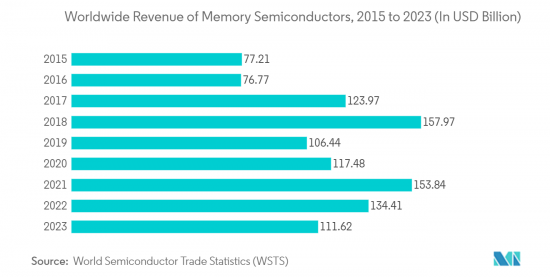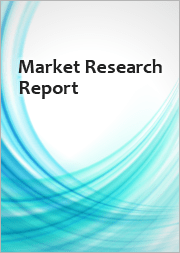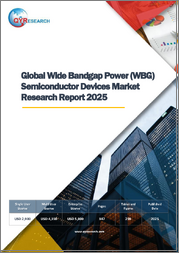
|
시장보고서
상품코드
1408767
가공용 반도체 디바이스-시장 점유율 분석, 산업 동향 및 통계, 성장 예측(2024-2029년)Semiconductor Device For Processing Applications - Market Share Analysis, Industry Trends & Statistics, Growth Forecasts 2024 - 2029 |
||||||
가공용 반도체 디바이스(Semiconductor Device For Processing Applications) 시장은 올해 2,011억 달러로 추정되며, CAGR 6.78%로 추이하며 성장 할 것으로 예상되며, 예측 기간 종료 시에는 2,792억 6,000만 달러에 이를 것으로 예측됩니다.

주요 하이라이트
- 반도체 산업은 급속한 성장을 이루고 있으며, 반도체는 모든 현대 기술의 기본 구성 요소입니다. 이 분야의 발전과 혁신은 결과적으로 모든 다운스트림 기술에 직접적인 영향을 미칩니다.
- 반도체는 모든 컴퓨팅 디바이스의 구성 요소를 형성합니다. 예를 들어, 많은 트랜지스터가 논리 게이트를 구성하고 컴퓨터가 사용하는 1 및 0 코드인 이진 정보를 처리합니다. 이러한 반도체 디바이스는 메모리 블록으로서 바이너리 코드를 유지할 수도 있습니다.
- 스마트폰, PC, 노트북 등 컴퓨팅 디바이스의 보급에 따라 세계·네트워크상에서 생성되어 종종 실시간으로 통신되는 데이터량이 급증하고 있습니다. 이 성장에 대응하기 위해 고성능 컴퓨팅(HPC)이 중요한 역할을 하게 되어 큰 성장을 이루고 있습니다. HPC는 데이터를 처리하고 복잡한 계산을 빠르게 수행하며 성능 집약적인 문제를 해결하는 것을 의미합니다. 센서 및 광전자와 같은 많은 반도체 디바이스는 HPC 용도을 구현하는 데 필요합니다.
- 고성능 컴퓨팅(HPC)은 반도체 산업의 중요한 촉진 요인으로 부상하고 있습니다.
- 게다가 COVID-19의 유행은 디지털 플랫폼과 클라우드 서비스의 이용을 가속화하고 데이터센터 개발의 급증을 가져왔습니다. 데이터센터는 용도 및 데이터를 저장 및 공유하는 시설입니다.
- 또한 반도체는 데이터센터의 주요 구성 요소 역할을 합니다. 중앙 처리 장치(CPU), 그래픽 처리 장치(GPU), 메모리, 네트워크 인프라용 칩, 전원 관리 등 다양한 장치가 사용됩니다. 그러므로 반도체 메모리 칩은 데이터센터에서 데이터를 저장하고 관리하는 중요한 장치이며, 그 성능은 데이터센터 운영의 성공에 필수적입니다.
반도체 디바이스 시장 동향
집적회로 아래 메모리가 시장 수요를 끌어올릴 전망
- 반도체 메모리는 집적 회로 상에 반도체 전자 디바이스를 실장한 디지털 전자 데이터 저장 장치입니다. DRAM, SRAM, NOR 플래시, NAND 플래시, ROM, EPROM 등 다양한 유형의 메모리가 있습니다. DRAM, SRAM, NAND 플래시, ROM, EPROM 등 다양한 유형의 메모리가 있으며, PC, 노트북, 카메라, 휴대폰 등 디지털 가전제품에 널리 사용되고 있습니다.
- 데이터센터 수요 증가도 메모리 부품 수요를 뒷받침하고 있습니다. 현재 북미의 대규모 데이터센터 프로젝트가 DRAM을 비롯한 메모리 수요의 호조에 기여하고 있습니다. 그러나 사용자 1인당 데이터센터 면적을 나타내는 지표에 따르면 중국의 인터넷 데이터센터는 적어도 미국의 22배, 적어도 현재 일본의 10배까지 성장할 전망입니다. 따라서 DRAM은 큰 성장 기회를 가지고 있으며 반도체 디바이스 산업에 영향을 미치고 있습니다.
- 또한 휴대용 시스템 시장이 성장함에 따라 반도체 산업은 대용량 저장 장치 용도의 비 휘발성 메모리(NVM) 기술에 관심을 갖고 있습니다. 보다 높은 효율성, 보다 빠른 메모리 액세스, 낮은 전력 소비에 대한 수요 증가는 NVM 시장 성장을 가속하는 중요한 요소 중 하나입니다. 데이터센터용도는 갑작스런 정전으로부터 데이터 유출을 보호하기 위해 NVM의 필요성이 증가하고 있습니다. 데이터센터 증가에 따라 차세대 비휘발성 메모리 도입도 증가하고 시장 성장을 견인할 것으로 예상됩니다.
- 게다가 WSTS에 따르면 2022년 메모리 컴포넌트 판매로 인한 수익은 1,344억 1,000만 달러에 이를 것으로 예측되었으며, 2021년에는 1,548억 4,000만 달러를 기록했습니다. 그러나 메모리 부품 판매 수익은 감소하고 1,116억 2,000만 달러로 추정되지만, 가까운 미래에 성장하고 2023년 말에는 좋은 성장을 달성할 가능성이 높습니다. 이러한 요인이 시장 성장을 뒷받침할 가능성이 높습니다.
- Samsung은 파트너십에 참여하고 있습니다. 최종 사용자는 다양한 장치 공급업체와 수직 통합 하드웨어 및 소프트웨어 회사가 향후 스토리지 솔루션을 지원할 것이라고 확신할 수 있습니다. 예를 들어, 2022년 3월 Samsung Electronics와 Western Digital은 차세대 데이터 배치, 처리, 패브릭(D2PF) 스토리지 기술의 표준화와 보급을 위해 협력하기로 합의했습니다. 양사는 이러한 단계를 밟아 업계가 광범위한 용도에 집중할 수 있게 되어 궁극적으로 고객에게 더 많은 가치를 제공할 수 있을 것으로 기대하고 있습니다.
- 또한 2022년 7월 Micron Technology, Inc.는 스토리지 솔루션의 전례 없는 성능을 이끌어내기 위해 업계를 선도하는 혁신으로 구축된 세계 최초의 232층 NAND의 양산을 시작했다고 발표했습니다. 이 회사의 232층 NAND는 3D NAND를 200층 이상으로 확장할 수 있음을 처음으로 입증한 것으로, 스토리지 혁신의 분수령이 됩니다.

유럽이 현저한 성장을 이룰 전망
- 유럽은 세계에서 가장 중요한 기술의 중심지이며 현대 기술의 중요한 추진자이자 도입자입니다. 첨단기술의 침투가 진행되고, 반도체 도입이 증가하고 있는 것이, 이 지역 시장 성장을 견인하고 있습니다.
- 사물인터넷(IoT)의 출현으로 반도체 디바이스는 모든 유형의 디바이스에 내장되어 컴퓨팅 및 데이터 스토리지의 적용 범위가 넓어지고 있습니다. 이러한 장치에 대한 수요도 꾸준히 증가하고 있습니다. 최첨단 메모리와 로직 디바이스, 전력 반도체 디바이스, 각종 센서의 성능을 향출시키기 위해 재료와 아키텍처는 꾸준히 진화하고 있습니다.
- 또한 5G 배포는 IoT 연결, 자동화 및 에지 기술의 실현으로 이어질 것으로 예상됩니다. 이 더 스마트한 표준의 새로운 장치는 메모리와 저장 용량이 더 커지고 고성능 웨이퍼를 생산할 것을 공장에 요구합니다.
- 5G 네트워크와 기술은 기존 시장 분야와 산업을 변화시킴으로써 무선 통신에 추가 혁명을 가져오려고 합니다. 이 회사에 따르면 2021년부터 2025년까지 5G는 유럽 경제의 모든 주요 산업에서 최대 2조억 유로(2조 1,700억 달러)의 신규 매출을 창출합니다. 따라서 5G를 실현하는 새로운 디바이스는 메모리와 스토리지 용량이 더 커지고 고성능 웨이퍼를 생산하는 팹이 필요합니다.
- 인텔은 2022년 3월 R&D, 제조 및 패키징 기술을 포함한 반도체 가치사슬 전체에서 향후 10년간 EU에 800억 유로(868억 4,000만 달러)를 투자할 계획의 첫 단계를 발표했습니다. 이 투자는 독일에서 반도체 공장 메가 사이트 설립, 프랑스에서 새로운 연구 개발 및 설계 시설 개발, 이탈리아, 폴란드, 아일랜드, 스페인에서 연구 개발, 제조 및 파운드리 서비스에 대한 투자에 약 170억 유로(184억 5,000만 달러)를 투자할 계획입니다.
반도체 디바이스 산업 개요
가공용 반도체 디바이스 시장은 통합의 진전, 기술의 진보, 진화하는 지정학적 시나리오 중에서 여러 경쟁자가 변동을 극복하고 있어 적당한 단편화를 경험하고 있습니다. 혁신을 통해 지속 가능한 경쟁 우위를 확립하는 것이 가장 중요한 시장에서 이러한 경쟁의 격화는 더욱 심각해질 것으로 보입니다. 반도체 제조 섹터의 최종 사용자로부터 품질에 대한 기대를 감안할 때, 브랜드 아이덴티티는 이러한 상황에서 매우 중요한 역할을 합니다.
주로 Intel Corporation, Nvidia Corporation, Kyocera Corporation, Qualcomm Technologies Inc. 등 업계를 선도하는 중요한 기존 기업의 존재로 시장 침투도는 두드러지게 높습니다.
2022년 4월 SKhynix는 산호세에 본사를 둔 자회사 Solidigum과 공동으로 데이터센터용으로 설계된 P5530으로 알려진 최신 SSD(SSD)를 발표했습니다. SSD는 플래시 메모리를 활용하여 데이터를 저장하는 것으로, 이 혁신적인 디바이스는 SKhynix의 주력 제품인 128층 4D NAND와 Solidigum의 SSD 컨트롤러를 조합한 것입니다.
2022년 3월 Samsung Electronics와 Western Digital은 차세대 데이터 배치, 처리, 패브릭(D2PF) 스토리지 기술의 표준화와 보급에 협력하기로 합의했습니다. 양사의 공동 노력은 업계의 관행을 간소화하고 궁극적으로 고객에게 더 큰 가치를 제공하는 광범위한 용도을 가능하게 하는 것입니다.
2022년 1월 Kioxia Corporation는 유니버설 플래시 스토리지(UFS) Ver.3.1 내장 플래시 메모리 디바이스 출시를 발표했습니다. 이 디바이스는 단일 패키지에서 사용 가능한 최고 밀도를 달성하는 능력을 갖춘 회사의 선구적인 셀당 4비트 쿼드 레벨 셀(QLC) 기술을 활용합니다. 이 기술은 특히 하이 엔드 스마트폰과 같은 고밀도 용도에 적합합니다.
기타 혜택 :
- 엑셀 형식 시장 예측(ME) 시트
- 3개월의 애널리스트 서포트
목차
제1장 서론
- 조사 전제 조건 및 시장 정의
- 조사 범위
제2장 조사 방법
제3장 주요 요약
제4장 시장 인사이트
- 시장 개요
- 기술 동향
- 산업 가치사슬/공급망 분석
- 업계의 매력 Porter's Five Forces 분석
- 공급기업의 협상력
- 구매자의 협상력
- 신규 참가업체의 위협
- 대체품의 위협
- 경쟁 기업간 경쟁 관계
- 거시 경제 동향이 시장에 미치는 영향
제5장 시장 역학
- 시장 성장 촉진 요인
- IoT나 AI등 기술 도입 확대
- 5G 보급과 데이터센터 수요 증가
- 시장 과제
- 반도체 칩 부족을 초래하는 공급 체인의 혼란
제6장 시장 세분화
- 디바이스 유형별
- 개별 반도체
- 광전자
- 센서
- 집적회로
- 아날로그
- 로직
- 메모리
- 마이크로
- 마이크로프로세서(MPU)
- 마이크로컨트롤러(MCU)
- 디지털 신호 프로세서
- 지역별
- 북미
- 유럽
- 아시아 태평양
- 세계 기타 지역
제7장 경쟁 구도
- 기업 개요
- Intel Corporation
- Nvidia Corporation
- Qualcomm Incorporated
- NXP Semiconductors NV
- SK Hynix Inc.
- Kyocera Corporation
- Samsung Electronics Co., Ltd.
- Advanced Micro Devices, Inc
- ST microelectronics Nv
- Micron Technology Inc.
- Toshiba Electronic Devices And Storage Corporation
- Infineon Technologies AG
제8장 투자 분석
제9장 시장의 미래
LYJ 24.01.30
The semiconductor device market for processing applications is estimated at USD 201.1 billion in the current year, registering a CAGR of 6.78%, to reach USD 279.26 billion by the end of the forecast period.
Key Highlights
- The semiconductor industry is witnessing rapid growth, with semiconductors emerging as the basic building blocks of all modern technology. The advancements and innovations in this field are resulting in a direct impact on all downstream technologies.
- Semiconductors form the building blocks of any computing device. For instance, many transistors make up a logic gate that processes binary information, the code of ones and zeros computers use. These semiconductor devices can also retain binary code as memory blocks.
- With the growing popularity of computing devices like smartphones, PCs, and laptops, the amount of data generated and communicated across a global network, often in real-time, has grown rapidly. To keep up with this growth, High-performance computing (HPC) has become crucial and is seeing significant growth. HPC refers to processing data and performing complex calculations at high speeds to solve performance-intensive problems. Many semiconductor devices like sensors and optoelectronics are required to enable HPC applications.
- High-performance computing (HPC) has emerged as an important growth driver for the semiconductor industry. For instance, Taiwan Semiconductor Manufacturing Co. (TSMC) expects the HPC platform to be the strongest-growing platform in 2022 and the largest contributor to the company's growth, fueled by the structural mega-trend, driving rising needs for higher computing power and energy-efficient computing.
- Further, the COVID-19 pandemic accelerated the use of digital platforms and cloud services, resulting in a surge in data center development. A data center is a facility that stores and shares applications and data.
- Also, semiconductors serve as a primary component for data centers. Different devices are used, like central processing units (CPUs), graphics processing units (GPUs), memory, chips for network infrastructure, and power management. Therefore, semiconductor memory chips are the key devices for storing and managing data in data centers, and their performance is crucial to the success of data center operations.
Semiconductor Device Market Trends
Memory Segment Under Integrated Circuits is Expected to Boost The Demand in The Market
- The semiconductor memory is a digital electronic data storage device implemented with semiconductor electronic devices on an integrated circuit. Different types of memory are available, such as DRAM, SRAM, Nor Flash, NAND Flash, ROM, and EPROM. They find widespread application in digital consumer products like PCs, laptops, cameras, and phones.
- The increasing demand for data centers is also bolstering the demand for memory components. Currently, large data center projects in North America have contributed to the strong demand for memory, such as DRAM. However, according to the measure of data center space per user, China's internet data centers are poised to grow to at least 22 times that of the United States or at least 10 times the current space of Japan. Hence, DRAM has a significant opportunity for growth and thus is impacting the semiconductor device industry.
- Further, the growth of the portable systems market attracted the semiconductor industry's interest in non-volatile memory (NVM) technologies for mass storage applications. The rise in demand for greater efficiency, faster memory access, and low power consumption are some of the significant factors driving the NVM market growth. There is an increasing need for NVM in data center applications to protect data losses from a sudden power outage. With the growth of data centers, the adoption of next-generation non-volatile memory is also expected to increase, driving market growth.
- Moreover, according to WSTS, In 2022, it is projected that revenue from memory component sales will amount to USD 134.41 billion, and in 2021 the recorded revenue of USD 154.84 billion. However, the revenue from memory component sales decreased, with an estimated amount of USD 111.62 billion, but it is likely to grow in the near future, and by the end of 2023, it will achieve good growth. Such factors are likely to boost the market growth.
- Samsung participates in partnerships; end users may be sure that various device suppliers and vertically integrated hardware and software firms will support its upcoming storage solutions. For instance, in March 2022, Samsung Electronics and Western Digital agreed to work together to standardize and promote next-generation data placement, processing, and fabrics (D2PF) storage technologies. They hope that by taking these steps, the industry will be able to concentrate on a wide range of applications that will ultimately provide customers with more value.
- Also, in July 2022, Micron Technology, Inc. announced that it had begun volume production of the world's first 232-layer NAND, built with industry-leading innovations to drive unprecedented performance for storage solutions. The company's 232-layer NAND is a watershed moment for storage innovation as the first proof of the capability to scale 3D NAND to more than 200 layers in production.

European Region Expected to Witness the Significant Growth
- The European region is home to some of the most crucial technology hubs across the globe and a critical driver and adopter of modern technology. The increasing penetration of advanced technologies and the increasing adoption of semiconductors drives market growth in the region.
- With the rise of the Internet of Things (IoT), semiconductor devices are being incorporated into all types of devices, with a wider range of computing and data storage applications. Demand for these devices is also steadily increasing. Materials and architecture are steadily evolving to improve the performance of cutting-edge memory and logic devices, power semiconductor devices, and various types of sensors.
- Furthermore, the rollout of 5G is perceived to be the enabler of IoT connectivity, automation, and edge technologies. New devices in this smarter standard will require fabs to produce higher-performing wafers with even greater capacity for memory and storage.
- 5G networks and technology are further revolutionizing wireless communications by transforming existing market sectors and industries. As per the company, between 2021 and 2025, 5G will drive up to EUR 2.0 trillion (USD 2.17 trillion) in total new sales across all major industries in the European economy. As such, new devices that enable 5G will require fabs to produce higher-performing wafers with even greater capacity for memory and storage.
- In March 2022, Intel issued the first phase of its EUR 80 billion (USD 86.84 billion) investment plan in the EU over the next decade across the semiconductor value chain, including R&D, manufacturing, and packaging technologies. Further in this investment, the company plans to invest approximately EUR 17 billion (USD 18.45 billion) in establishing a semiconductor fab mega-site in Germany, as well as the development of a new R&D and design facility in France, and to invest in R&D, manufacturing, and foundry services in Italy, Poland, Ireland, and Spain.
Semiconductor Device Industry Overview
The semiconductor device market for processing applications is experiencing moderate fragmentation, with several competitors navigating fluctuations amidst growing consolidation, technological advancements, and evolving geopolitical scenarios. This heightened competition is set to intensify in a market where establishing a sustainable competitive advantage through innovation is of paramount importance. Given the expectations of quality from end-users in the semiconductor manufacturing sector, brand identity plays a pivotal role in this landscape.
The market penetration levels are notably high, primarily due to the presence of significant market incumbents such as Intel Corporation, Nvidia Corporation, Kyocera Corporation, Qualcomm Technologies Inc., and other industry leaders.
In April 2022, SK Hynix Inc. introduced its latest solid-state drive (SSD), known as the P5530, designed for data centers in collaboration with its San-Jose-based subsidiary, Solidigm. SSDs leverage flash memory to store data, and this innovative device combines SK Hynix's 128-layer 4D NAND, a core product, with Solidigm's SSD controller.
In March 2022, Samsung Electronics and Western Digital reached an agreement to collaborate on standardizing and promoting next-generation data placement, processing, and fabrics (D2PF) storage technologies. Their joint efforts aim to streamline industry practices, allowing for a broader array of applications that ultimately deliver greater value to customers.
In January 2022, Kioxia Corporation announced the launch of Universal Flash Storage (UFS) Ver. 3.1 embedded flash memory devices. These devices harness the company's pioneering 4-bit per cell quad-level-cell (QLC) technology, which has the capability to achieve the highest densities available in a single package. This technology is particularly suited for high-density applications like high-end smartphones
Additional Benefits:
- The market estimate (ME) sheet in Excel format
- 3 months of analyst support
TABLE OF CONTENTS
1 INTRODUCTION
- 1.1 Study Assumptions and Market Definition
- 1.2 Scope of the Study
2 RESEARCH METHODOLOGY
3 EXECUTIVE SUMMARY
4 MARKET INSIGHTS
- 4.1 Market Overview
- 4.2 Technological Trends
- 4.3 Industry Value Chain/Supply Chain Analysis
- 4.4 Industry Attractiveness Porter's Five Forces Analysis
- 4.4.1 Bargaining Power of Suppliers
- 4.4.2 Bargaining Power of Buyers
- 4.4.3 Threat of New Entrants
- 4.4.4 Threat of Substitutes
- 4.4.5 Intensity of Competitive Rivalry
- 4.5 Impact of the Macroeconomics Trends on the Market
5 MARKET DYNAMICS
- 5.1 Market Drivers
- 5.1.1 Growing Adoption of Technologies Like IoT And AI
- 5.1.2 Increased Deployment of 5G And Rising Demand For Data Centers
- 5.2 Market Challenges
- 5.2.1 Supply Chain Disruptions Resulting In Semiconductor Chip Shortage
6 MARKET SEGMENTATION
- 6.1 By Device Type
- 6.1.1 Discrete Semiconductors
- 6.1.2 Optoelectronics
- 6.1.3 Sensors
- 6.1.4 Integrated Circuits
- 6.1.4.1 Analog
- 6.1.4.2 Logic
- 6.1.4.3 Memory
- 6.1.4.4 Micro
- 6.1.4.4.1 Microprocessors (MPU)
- 6.1.4.4.2 Microcontrollers (MCU)
- 6.1.4.4.3 Digital Signal Processors
- 6.2 By Geography
- 6.2.1 North America
- 6.2.2 Europe
- 6.2.3 Asia Pacific
- 6.2.4 Rest of the World
7 COMPETITIVE LANDSCAPE
- 7.1 Company Profiles
- 7.1.1 Intel Corporation
- 7.1.2 Nvidia Corporation
- 7.1.3 Qualcomm Incorporated
- 7.1.4 NXP Semiconductors NV
- 7.1.5 SK Hynix Inc.
- 7.1.6 Kyocera Corporation
- 7.1.7 Samsung Electronics Co., Ltd.
- 7.1.8 Advanced Micro Devices, Inc
- 7.1.9 ST microelectronics Nv
- 7.1.10 Micron Technology Inc.
- 7.1.11 Toshiba Electronic Devices And Storage Corporation
- 7.1.12 Infineon Technologies AG



















